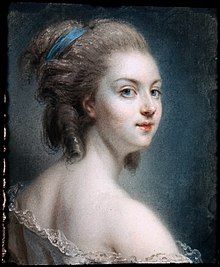Rosalie Duthé
Rosalie Duthé | |
|---|---|
 Presumed portrait of Rosalie Duthe, Claude-Jean-Baptiste Hoin (1750–1817) | |
| Born | Catherine-Rosalie Gerard Duthé 1748 |
| Died | 1830 (aged 81–82) |
| Resting place | Père Lachaise Cemetery, Paris |
| Occupation | Courtesan |
Catherine-Rosalie Gerard Duthé (1748–1830),
Biography
After quitting a French
In Parisian society, Duthé developed a certain "reputation by adopting the habit of pausing for extended periods of time before speaking."
Duthé was the supposed author of an
Rosalie Duthé died in 1830, probably around the age of 82.[1] She is buried at Père Lachaise Cemetery.[11]
In art


Duthé was often requested by portrait painters for sittings, including for partial and full nudes.
Henri-Pierre Danloux (1753–1809) was Duthé's favorite artist, and he recorded some of his sessions with her in his diary.[12] Danloux painted a number of portraits, including Mademoiselle Rosalie Duthé (1792), commissioned by Duthe's friend and banker Jean-Frédéric Perregaux, who is said to have contemplated this image on his death-bed.[12] Claude-Jean-Baptiste Hoin (1750–1817) painted Presumed portrait of Rosalie Duthé (date unknown).
Other painters who made portraits include
Notes
References
- ^ ISBN 9780313329685.
- ^ ISBN 9781582341200.
- ^ a b Victoria Sherrow. Encyclopedia of hair: a cultural history. Page 149
- ^ a b Laura Clout (19 Nov 2007). "Blonde women make men less clever". The Daily Telegraph. Archived from the original on April 11, 2016.
- ^ Frederic George Stephens (1870). Catalogue of prints and drawings in the British Museum: Division I. Political and personal satires. British Museum. Dept. of Prints and Drawings. p. 131.
- ^ Denys Sutton (1968). France in the Eighteenth Century: Royal Academy of Arts, Winter Exhibition, [6 January-3 March] 1968, p. 125
- ^ a b Alain Guédé. Monsieur de Saint-George: virtuoso, swordsman, revolutionary, Page 72
- OCLC 936144129.
- ^ Catherine Rosalie Gerard Duthe (1909). Souvenirs de Mlle Duthe de l'opera, 1748–1830. Avec introd. et notes de Paul Ginisty. Paris: L. Michaud. Retrieved September 21, 2016.
- ^ William Pettigrew Gibson. Miniatures and illuminations. 1935
- ^ DUTHE Rosalie Catherine GERARD dite la (1748-1830). Last accessed April 2012.
- ^ a b c d e f g h i Olivier Blanc, Portraits de femmes, artistes et modèles au temps de Marie-Antoinette, Paris, Didier Carpentier, 2006[page needed]
- ISBN 0380487772.
